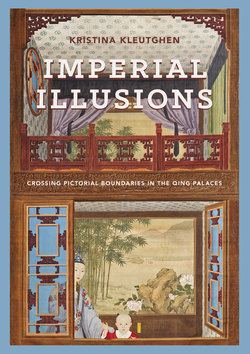Читать книгу Imperial Illusions - Kristina Kleutghen - Страница 70
На сайте Литреса книга снята с продажи.
ОглавлениеChinese painters, The Study of Vision was the only treatise on Western-style painting produced until the very end of the Qing dynasty, when progressive changes to art education began to incorporate foreign methods.
Although it is impossible to conclusively attribute the development of scenic illusion paintings at the Yongzheng court to Giuseppe Castiglione, it is significant that Nian specifically credits Castiglione as the teacher from whom he learned Western painting. Castiglione was the only European painter present at the Yongzheng court after Matteo Ripa returned to Italy in 1723, and Nian’s two investigations into illusionistic painting were both published during the following years, when scenic illusions were developed. Nian takes pains to point out that the differences between Western and Chinese painting lay not in some inherent biological or even cultural difference in human vision, but rather in the practical techniques of pictorial representation, which led to different results. He argues that the production, rather than the perception, of pictorial illusions was culturally conditioned because of the differences between Chinese literati antimimetic and antitechnical ink painting as a means of self-expression on the one hand and, on the other, Western perspectival illusionistic painting, which was grounded in mathematics, taught techniques, and technical drawing using tools as a means of achieving mimesis. Nian therefore equated linear perspective with illusionistic painting, just as the term “perspectival painting” was interchangeable with “scenic illusion painting” at the Qing court. The Study of Vision is therefore the key to understanding how linear perspective was transformed from a novel aspect of technical knowledge for Kangxi into the familiar basis of scenic illusions for Qianlong.
The Study of Vision has been difficult to categorize. The Jesuit introduction of linear perspective alongside mathematics and astronomy, along with Nian’s identity as an amateur mathematician and his otherwise exclusively scientific publication history, are perhaps responsible for its only full facsimile publication being within a compendium of scientific and technical texts.1 Most scholars consider it an art treatise; however, it has been omitted from discussions both of Chinese mathematics and of huapu, the broad category that comprises Chinese painting manuals, painting catalogues, and art treatises. Huapu peaked in the late Ming dynasty between 1570 and 1620, roughly concurrent with the apex of the late imperial printed book industry and Dong Qichang’s codification of literati painting.2 These manuals emphasized literati painting aesthetics, subjects, and pictorial treatments, and recent research suggests that they were published as much for artists as for a broad readership interested in developing the social and cultural markers of the intellectual elite.3 Other than being a woodblock-printed publication that combines instructions and illustrations, The Study of Vision bears little resemblance to the standard definition of Chinese painting manuals. Neither a mathematical treatise nor a manual on literati painting, The Study of Vision is sui generis, dissolving the barriers often raised between art and mathematics in the study of High Qing art that engages Western ideas. Like much of Nian Xiyao’s life and work, it should instead be placed at the intersection of these two areas.
